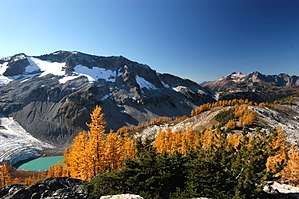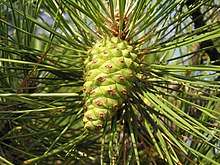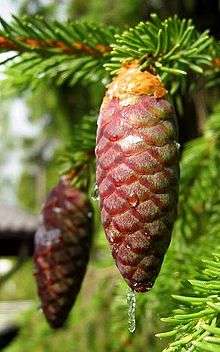Pinaceae
The Pinaceae, pine family, are trees or shrubs, including many of the well-known conifers of commercial importance such as cedars, firs, hemlocks, larches, pines and spruces. The family is included in the order Pinales, formerly known as Coniferales. Pinaceae are supported as monophyletic by their protein-type sieve cell plastids, pattern of proembryogeny, and lack of bioflavonoids. They are the largest extant conifer family in species diversity, with between 220 and 250 species (depending on taxonomic opinion) in 11 genera,[1] and the second-largest (after Cupressaceae) in geographical range, found in most of the Northern Hemisphere, with the majority of the species in temperate climates, but ranging from subarctic to tropical. The family often forms the dominant component of boreal, coastal, and montane forests. One species, Pinus merkusii, grows just south of the equator in Southeast Asia.[2] Major centres of diversity are found in the mountains of southwest China, Mexico, central Japan, and California.
| Pinaceae | |
|---|---|
 | |
| Larix (golden), Abies (central foreground) and Pinus (right foreground) | |
| Scientific classification | |
| Kingdom: | Plantae |
| Clade: | Tracheophytes |
| Division: | Pinophyta |
| Class: | Pinopsida |
| Order: | Pinales |
| Family: | Pinaceae Lindley, 1836 |
| Genera (no. of species) | |
| |
Description

Members of the family Pinaceae are trees (rarely shrubs) growing from 2 to 100 m (7 to 300 ft) tall, mostly evergreen (except the deciduous Larix and Pseudolarix), resinous, monoecious, with subopposite or whorled branches, and spirally arranged, linear (needle-like) leaves.[1] The embryos of Pinaceae have three to 24 cotyledons.
The female cones are large and usually woody, 2–60 cm (1–24 in) long, with numerous spirally arranged scales, and two winged seeds on each scale. The male cones are small, 0.5–6.0 cm (0.2–2 in) long, and fall soon after pollination; pollen dispersal is by wind. Seed dispersal is mostly by wind, but some species have large seeds with reduced wings, and are dispersed by birds. Analysis of Pinaceae cones reveals how selective pressure has shaped the evolution of variable cone size and function throughout the family. Variation in cone size in the family has likely resulted from the variation of seed dispersal mechanisms available in their environments over time. All Pinaceae with seeds weighing less than 90 mg are seemingly adapted for wind dispersal. Pines having seeds larger than 100 mg are more likely to have benefited from adaptations that promote animal dispersal, particularly by birds.[3] Pinaceae that persist in areas where tree squirrels are abundant do not seem to have evolved adaptations for bird dispersal.
Boreal conifers have many adaptions for winter. The narrow conical shape of northern conifers, and their downward-drooping limbs help them shed snow, and many of them seasonally alter their biochemistry to make them more resistant to freezing, called "hardening".
Classification


Classification of the subfamilies and genera of Pinaceae has been subject to debate in the past. Pinaceae ecology, morphology, and history have all been used as the basis for methods of analyses of the family. An 1891 publication divided the family into two subfamilies, using the number and position of resin canals in the primary vascular region of the young taproot as the primary consideration. In a 1910 publication, the family was divided into two tribes based on the occurrence and type of long–short shoot dimorphism.
A more recent classification divided the subfamilies and genera based on the consideration of features of ovulate cone anatomy among extant and fossil members of the family. Below is an example of how the morphology has been used to classify Pinaceae. The 11 genera are grouped into four subfamilies, based on the microscopical anatomy and the morphology of the cones, pollen, wood, seeds, and leaves:[4]
- Subfamily Pinoideae (Pinus): cones are biennial, rarely triennial, with each year's scale-growth distinct, forming an umbo on each scale, the cone scale base is broad, concealing the seeds fully from abaxial view, the seed is without resin vesicles, the seed wing holds the seed in a pair of claws, leaves have primary stomatal bands adaxial (above the xylem) or equally on both surfaces.
- Subfamily Piceoideae (Picea): cones are annual, without a distinct umbo, the cone scale base is broad, concealing the seeds fully from abaxial view, seed is without resin vesicles, blackish, the seed wing holds the seed loosely in a cup, leaves have primary stomatal bands adaxial (above the xylem) or equally on both surfaces.
- Subfamily Laricoideae (Larix, Pseudotsuga, and Cathaya): cones are annual, without a distinct umbo, the cone scale base is broad, concealing the seeds fully from abaxial view, the seed is without resin vesicles, whitish, the seed wing holds the seed tightly in a cup, leaves have primary stomatal bands abaxial (below the phloem vessels) only.
- Subfamily Abietoideae (Abies, Cedrus, Pseudolarix, Keteleeria, Nothotsuga, and Tsuga): cones are annual, without a distinct umbo, the cone scale base is narrow, with the seeds partly visible in abaxial view, the seed has resin vesicles, the seed wing holds the seed tightly in a cup, leaves have primary stomatal bands abaxial (below the phloem vessels) only.
Some genera of interest include Pinus, Picea, Abies, Cedrus, Larix, Tsuga and Pseudotsuga.[5]
Defense mechanisms
External stresses on plants have the ability to change the structure and composition of forest ecosystems. Common external stress that Pinaceae experience are herbivore and pathogen attack which often leads to tree death.[6] In order to combat these stresses, trees need to adapt or evolve defenses against these stresses. Pinaceae have evolved a myriad of mechanical and chemical defenses, or a combination of the two, in order to protect themselves against antagonists.[7] Pinaceae have the ability to up-regulate a combination of constitutive mechanical and chemical strategies to further their defenses.[8]
Pinaceae defenses are prevalent in the bark of the trees. This part of the tree contributes a complex defensive boundary against external antagonists.[9] Constitutive and induced defenses are both found in the bark.[9][10][11]
Constitutive defenses
Constitutive defenses are typically the first line of defenses used against antagonists and can include sclerified cells, lignified periderm cells, and secondary compounds such as phenolics and resins.[12][9][10] Constitutive defenses are always expressed and offer immediate protection from invaders but could also be defeated by antagonists that have evolved adaptations to these defense mechanisms.[12][9] One of the common secondary compounds used by Pinaceae are phenolics or polyphenols. These secondary compounds are preserved in vacuoles of polyphenolic parenchyma cells (PP) in the secondary phloem.[13][11]
Induced defenses
Induced defense responses need to be activated by certain cues, such as herbivore damage or other biotic signals.[12]
A common induced defense mechanism used by Pinaceae is resins.[14] Resins are also one of the primary defenses used against attack.[7] Resins are short term defenses that are composed of a complex combination of volatile mono- (C10) and sesquiterpenes (C15) and nonvolatile diterpene resin acids (C20).[7][14] They are produced and stored in specialized secretory areas known as resin ducts, resin blisters, or resin cavities.[14] Resins have the ability to wash away, trap, fend off antagonists, and are also involved in wound sealing.[13] They are an effective defense mechanism because they have toxic and inhibitory effects on invaders, such as insects or pathogens.[15] Resins could have developed as an evolutionary defense against bark beetle attacks.[14] One well researched resin present in Pinaceae is oleoresin. Oleoresin had been found to be a valuable part of the conifer defense mechanism against biotic attacks.[15] They are found in secretory tissues in tree stems, roots, and leaves.[15] Oleoresin is also needed in order to classify conifers.[15]
Active research: methyl jasmonate (MJ)
The topic of defense mechanisms within family Pinaceae is a very active area of study with numerous studies being conducted. Many of these studies use methyl jasmonate (MJ) as an antagonist.[10][11][16] Methyl jasmonate is known to be able to induce defense responses in the stems of multiple Pinaceae species.[10][16] It has been found that MJ stimulated the activation of PP cells and formation of xylem traumatic resin ducts (TD). These are structures that are involved in the release of phenolics and resins, both forms of defense mechanism.[10][11]
 Close up of bishop pine cones
Close up of bishop pine cones Knobcone pine cone
Knobcone pine cone
References
- Aljos Farjon (1998). World Checklist and Bibliography of Conifers. Royal Botanic Gardens, Kew. ISBN 978-1-900347-54-9.
- Earle, Christopher J., ed. (2018). "Pinus merkusii". The Gymnosperm Database. Retrieved March 17, 2015.
- Craig W. Benkman (1995). "Wind dispersal capacity of pine seeds and the evolution of different seed dispersal modes in pines" (PDF). Oikos. 73 (2): 221–224. doi:10.2307/3545911. JSTOR 3545911.
- Robert A. Price, Jeanine Olsen-Stojkovich & Jerold M. Lowenstein (1987). "Relationships among the genera of Pinaceae: an immunological comparison". Systematic Botany. 12 (1): 91–97. doi:10.2307/2419217. JSTOR 2419217.
- Gerhold, Henry D. A Century of Forest Resources Education at Penn State. p. 21.
- Cherubini, Paolo; Fontana, Giovanni; Rigling, Daniel; Dobbertin, Matthias; Brang, Peter; Innes, John L. (2002). "Tree-Life History Prior to Death: Two Fungal Root Pathogens Affect Tree-Ring Growth Differently". Journal of Ecology. 90 (5): 839–850. doi:10.1046/j.1365-2745.2002.00715.x. JSTOR 3072253.
- "Terpenoid biosynthesis and specialized vascular cells of conifer defense. - Semantic Scholar". Retrieved 2018-03-10.
- Franceschi, Vincent R.; Krokene, Paal; Christiansen, Erik; Krekling, Trygve (2005-08-01). "Anatomical and chemical defenses of conifer bark against bark beetles and other pests". New Phytologist. 167 (2): 353–376. doi:10.1111/j.1469-8137.2005.01436.x. ISSN 1469-8137. PMID 15998390.
- Franceschi, V. R., P. Krokene, T. Krekling, and E. Christiansen. 2000. Phloem parenchyma cells are involved in local and distance defense response to fungal inoculation or bark-beetle attack in Norway spruce (Pinaceae). American Journal of Botany 87:314-326.
- Hudgins, J. W.; Christiansen, E.; Franceschi, V. R. (2004-03-01). "Induction of anatomically based defense responses in stems of diverse conifers by methyl jasmonate: a phylogenetic perspective". Tree Physiology. 24 (3): 251–264. doi:10.1093/treephys/24.3.251. ISSN 0829-318X.
- Krokene, P.; Nagy, N. E.; Solheim, H. (2008-01-01). "Methyl jasmonate and oxalic acid treatment of Norway spruce: anatomically based defense responses and increased resistance against fungal infection". Tree Physiology. 28 (1): 29–35. doi:10.1093/treephys/28.1.29. ISSN 0829-318X. PMID 17938111.
- Sampedro, L. (2014-09-01). "Physiological trade-offs in the complexity of pine tree defensive chemistry". Tree Physiology. 34 (9): 915–918. doi:10.1093/treephys/tpu082. ISSN 0829-318X. PMID 25261122.
- Nagy, N. E.; Krokene, P.; Solheim, H. (2006-02-01). "Anatomical-based defense responses of Scots pine (Pinus sylvestris) stems to two fungal pathogens". Tree Physiology. 26 (2): 159–167. doi:10.1093/treephys/26.2.159. ISSN 0829-318X. PMID 16356912.
- Nagy, Nina E.; Franceschi, Vincent R.; Solheim, Halvor; Krekling, Trygve; Christiansen, Erik (2000-03-01). "Wound-induced traumatic resin duct development in stems of Norway spruce (Pinaceae): anatomy and cytochemical traits". American Journal of Botany. 87 (3): 302–313. doi:10.2307/2656626. ISSN 1537-2197. JSTOR 2656626.
- Lewinsohn, Efraim; Gijzen, Mark; Croteau, Rodney (1991-05-01). "Defense Mechanisms of Conifers: Differences in Constitutive and Wound-Induced Monoterpene Biosynthesis Among Species". Plant Physiology. 96 (1): 44–49. doi:10.1104/pp.96.1.44. ISSN 0032-0889. PMC 1080711. PMID 16668184.
- Fäldt, Jenny; Martin, Diane; Miller, Barbara; Rawat, Suman; Bohlmann, Jörg (2003-01-01). "Traumatic resin defense in Norway spruce (Picea abies): Methyl jasmonate-induced terpene synthase gene expression, and cDNA cloning and functional characterization of (+)-3-carene synthase". Plant Molecular Biology. 51 (1): 119–133. doi:10.1023/A:1020714403780. ISSN 0167-4412. PMID 12602896.
Further reading
- Heinz-Dietmar Behnke (1974). "Sieve element plastids of Gymnospermae: their ultrastructure and relation to systematics". Plant Systematics and Evolution. 123 (1): 1–12. doi:10.1007/BF00983281.
- D. F. Greene & E. A. Johnson (1990). "The dispersal of winged fruits and seeds differing in autorotative behavior". Canadian Journal of Botany. 68 (12): 2693–2697. doi:10.1139/b90-340.
- A. Liston, D. S. Gernandt, T. F. Vining, C. S. Campbell & D. Piñero (2003). R. R. Mill (ed.). Molecular phylogeny of Pinaceae and Pinus. Proceedings of the Fourth International Conifer Conference. Acta Horticulturae. 615. Brugge: International Society for Horticultural Science. pp. 107–114.CS1 maint: multiple names: authors list (link)
- Zsolt Debreczy; Istvan Racz (2012). Conifers Around the World. DendroPress. ISBN 978-9632190617.
External links
| Wikimedia Commons has media related to Pinaceae. |
| Wikispecies has information related to Pinaceae |
- Arboretum de Villardebelle French Arboretum of conifers around the world
- Gymnosperm Database – Pinaceae
- Pinaceae on the web page of the Tree-of-Life project
- 40 Pine Trees From Around the World by The Spruce
- Key to Pinaceae from the Jepson Manual, covers Californian species and much of western North America
- Pinaceae in Flora of North America
- Pinus in USDA Plants Database